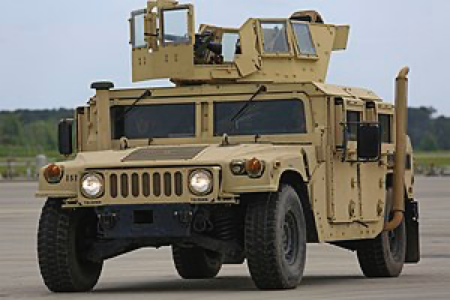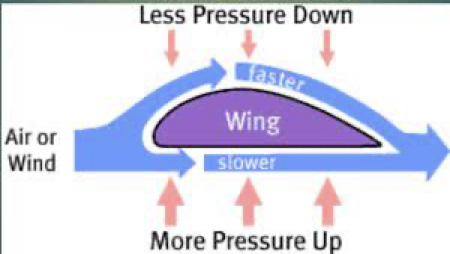
Steel is hard . . . a law unto itself. It can’t be twisted, bent or broken with one’s hands. There is no contest between human skin, muscle and bone and this inflexible metal. So I have wondered how it is that military Humvees (High Mobility Multipurpose Wheeled Vehicle – HMMWV; pictured at left), a rugged, steel-framed vehicle weighing about 8000 pounds and costing $46,000 each could be blown apart in Afghanistan by small incendiary devises. How can steel be torn, twisted and destroyed by some chemicals coming in contact with each other?
In his book The Great Halifax Explosion, John U. Bacon gives us a bit of history. Explosives require two components – fuel and an oxidizer – to ignite. How destructive an explosion is depends largely on how quickly these two elements combine. Another factor is speed – the rate of the chemical reaction (decomposition) of low explosives is less than the speed of sound (767 miles per hour).
Propane, gasoline and gunpowder are rated as “low” (and slow) explosives. In contrast, an explosive rated “high” combines the fuel and the oxidant in a single molecule, making each one a self-contained bomb. To ignite high explosives usually requires extreme heat or a solid bump. Once ignited, these single “bombs” detonate instantaneously – faster than the speed of sound. Flash of light, sonic boom, incredible heat and immense pressure caused by the instantaneous production of gas and expanding air all work together to create airwaves associated with nuclear explosions.
Low explosives have been around for centuries, but the discovery of high explosives happened recently. In 1863, a German scientist (Joseph Wilbrand) discovered something called trinitrotoluene – which was highly destructive. It is better known as TNT.
In 1867, a Swedish inventor who already had 355 patents to his credit found that nitroglycerin, an extremely unstable high explosive, could be handled safely if it were first absorbed into a porous material such as clay, sawdust or cotton. Alfred Nobel called his invention dynamite. And he made a fortune on it.
In 1871, another German chap came up with something 10 percent more efficient that TNT. And who knows what lovely other things have been developed since the Manhattan Project produced Little Boy for use in Hiroshima and Nagasaki.
What I did not know was how explosives could destroy the brute steel strength of a Humvee. Cold, strong steel is no match for high explosives.
The point is a whole powerful world of explosives awaited to be discovered. God designed the physical world with chemicals which had enormous power. That power lay hidden until almost 2000 after Christ died on a cross for the sins of humanity.

Consider a second example of what we did not know for a long, long time. For at least 2000 years, the world wondered how birds could fly. Leonardo da Vinci experimented with flying machines in 1487 (you have seen his drawings). Daniel Bernoulli, 1700 – 1782; pictured at left, discovered his famous principle of flight. Around 1880, interest continued to increase as men became more eager to fly. Aviation interest built toward Kitty hawk, January 8, 1904 and Orville and Wilber Wright. It had taken a long time to apply Bernoulli’s principle to flight.

Here’s the principle — when the wing of an airplanes splits two air molecules, the air going under the wing will reach the back of the wing at the same time as the second air molecule that goes over the wing, but the over-the-wing molecule has to travel farther and faster, making it lighter, resulting in “lift.” Put another way, “Bernoulli’s principle explains that an aircraft can achieve lift because of the shape of its wings. They are shaped so that air flows faster over the top of the wing and slower underneath. Fast moving air equals lower air pressure while slow moving air equals higher air pressure” (Wikipedia). Based simply on the shape of a wing, a fully loaded 747 (weighing 900,000 pounds) gets off the ground. Humanity waited a long, long time to discover “Bernoulli’s Principle of Flight.”

What else awaits? What else is mysterious to us?
The oceans! I believe at some point God will allow us to discover why He covered 73% of the earth’s surface with water. I believe we will discover vast purposes for the ocean which are simply unknown today.
Significant discoveries await in medicine. Space, the Arctic and the Australian outback are other great unknowns. And the human mind awaits to be unlocked.
Proverbs 25 says, “It is the glory of God to conceal a matter; to search out a matter is the glory of kings.” So God hides things and people slowly discover them. Oh to “search out a matter.”
The greatest discoveries are spiritual in nature. The Lord Jesus Christ spoke of “true riches” in Luke 16:11 – Who will trust you with true riches?” During the course of a life, we discover some of these riches. However, I believe that most of God’s riches are yet to be experienced. Oh to meet the requirements of Luke 16:8-10 that we would experience “true riches.”


Recent Comments